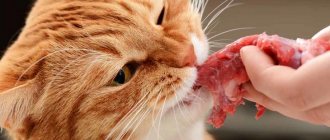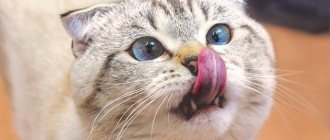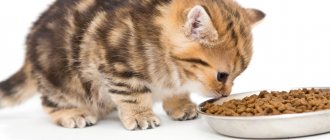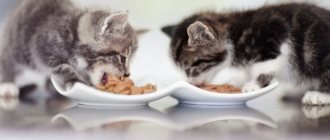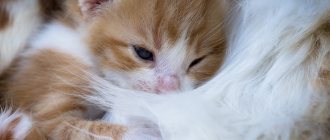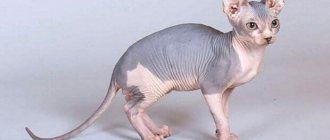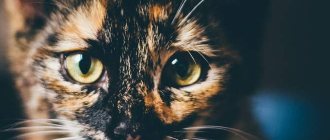Proper diet for cats
- Fact 1:
It is better not to give milk to a Bengal kitten. Only goat (low-fat) is allowed to avoid problems with digestion - Fact 2:
By the way, food for pregnant and lactating cats is also suitable for babies (almost identical composition to food for kittens). - Fact 3:
Bengals do not like fatty meats, so it is better to avoid beef and pork. - Fact 4:
You can cook a porridge mix from cereals, herbs and vegetables (but do not include potatoes, broccoli, onions and garlic)
A Bengal cat is a piece of wild nature in your home. Such beauty was achieved by crossing a simple domestic cat with a wild leopard cat. That is why the Bengal creature has an unusual spotted color and a completely ordinary “domestic” character. Of course, 20% of wild genes sometimes wake up in a pet, which is reflected in its disposition and food preferences.
The wild brothers of the Bengal cat hunt for their own diet: it is exclusively meat. Very rarely, leopard cats practice herbal medicine. Therefore, for the most part, the handsome Bengal will have to be fed with food of animal origin, and industrial food should only be of the highest quality.
Secrets of the Bengal diet
Despite the 100% meat diet of the leopard cat, you need to remember that Bengals are half domestic. And it is not necessary to feed them only meat. At least 20% of the diet should consist of other dishes: sea fish, cereals, vegetables, fermented milk cuisine. It is better not to give milk to a Bengal kitten. Only goat (low-fat) is allowed so that there are no problems with digestion.
You can cook a porridge mix from cereals, herbs and vegetables (but do not include potatoes, broccoli, onions and garlic). It is recommended to add 1 quail egg yolk to the porridge 1-2 times a week. If you have your own farm, or the eggs are purchased from trusted sources, raw yolk is allowed and mixed into the porridge. If the eggs were purchased in a store or from unverified sources, it is better not to take risks: you can infect the kitten with salmonellosis. Sometimes you can replace meat with offal (liver, heart). Bengals do not take well to fatty meats, so it is better to avoid beef and pork.
Make sure that your pet does not come across “surprises” in meat dishes: bones, beaks, skin, claws. The kitten may choke. Food must be at an acceptable temperature. Vitamins and minerals are required and must be discussed with your veterinarian. The kitten should have regular access to fresh drinking water.
Some useful tips
How much food should I feed? Bengals are not gluttons; they usually eat as much food as they need. Anything left after eating should be removed. Problems with overeating sometimes occur in neutered dogs. If the kitten becomes overweight, you need to reduce the portion size and control the calorie content of the food.
Bengals are active and always have a good appetite. When a kitten of any age does not eat or drink or drinks little water, this is a very dangerous symptom. He needs to be taken to the vet immediately.
A kitten's digestion will benefit if the pet receives food on a regular schedule. An egg, like chopped vegetables, can be added to porridge. It must be very fresh and from a trusted source to prevent salmonella contamination.
Bengals love to drink water and play with it with pleasure. For drinking you need a spacious and heavy bowl. Plastic will not work; it is better to take a container made of glass, ceramics or stainless steel. It will be inconvenient to drink from a small bowl; a playful pet may turn over a light plastic product. Feeding containers should also be spacious and heavy. Use only clean drinking water. If the quality of tap water does not meet these requirements, you need to buy bottled water without gas.
If the kitten remains active, looks healthy, has a shiny coat and normal stool, we can confidently assume that the diet has been chosen correctly. High-quality food, good care, and ample space for play will provide protection—everything Bengals need to be happy.
Ready-made food: tips and nuances
If you decide to please your Bengal pet with the highest quality industrial food, make sure that the label says “For kittens.” By the way, food for pregnant and lactating cats is also suitable for babies (almost identical composition to food for kittens). It’s impossible to say for sure which industrial food your baby will love. Cats, like people, have their own food preferences.
But wise intervention by the owner in the diet is mandatory. It is better not to mix different brands of food, just as you should not give ready-made food with “natural” food in the same bowl. Make it a rule: each type of food is in its own bowl.
Expert cat breeders recommend Royal Canin for any breed as a proven food. But besides this, there are several other excellent cat treats.
Dry food
- "Royal Canin Mother & Babycat" . Suitable for both pregnant cats and babies up to 4 months (although many owners successfully give this food to kittens up to 7 months of age). Special proteins and prebiotics are perfectly absorbed, and vitamins and antioxidants support the Bengal baby’s immunity. Pieces of food are easy to soak, which helps to painlessly transfer the kitten from milk to solid food.
- "Royal Canin Kitten " Recommended for kittens from 4 months to one year. Special proteins and fiber from plantain seeds take care of the baby’s gastrointestinal tract, regulate the balance of intestinal microflora and relieve problems with stool. The food is rich in vitamins and is able to fully provide energy and protection to the kitten’s growing body.
- "Sanabelle Kitten " Suitable for pregnant cats and babies up to one year old. Amino acids of the highest quality and the correct proportion of nutrients have a beneficial effect on the entire cat’s body: strengthens bones and teeth, regulates the gastrointestinal tract, takes care of the kitten’s fur and skin, and most importantly, supports its strong immunity. Experts joke that this food is so tasty and safe that the owners themselves would gladly feast on it if not for moral prejudices.
Wet food (canned)
- "Pro Plan Nutris Vour Junior" . Everything a small cat's body needs is contained in a serving of this healthy food. Omega-3 fatty acids improve vision and brain function. Calcium and phosphorus build the baby's skeleton and muscles. The balanced formula of the canned food is suitable for the first feeding of a kitten, as well as for a nursing mother cat.
- "Iams Kitten & Junior Chicken in Sause" . Canned chicken meat is great for kittens from 3 weeks to one year. The appetizing pieces in the sauce contain the required amount of all valuable substances: proteins, calcium, phosphorus, fiber, fats and vitamins. Their correct balance helps the kitten to fully develop and have a healthy, strong immune system. Canned kibble can be mixed with any other food to make your pet’s diet as tasty and healthy as possible.
What you should absolutely not give
What to give your pet - dry food or natural food - is up to you. To prevent your animal from having intestinal problems, take note of the list of treats that you should never feed it with. The following prohibited products are identified:
- fatty meat (duck, pork, turkey). Firstly, it will be difficult for the cat to absorb. Secondly, a cat can become infected with helminths or dangerous infectious diseases from poultry;
- smoked and spicy dishes;
- sweets. This is generally taboo for the Bengal cat. From them, her teeth and fur can deteriorate, and her metabolism is noticeably disrupted;
- peas, beans and soybeans. If your pet consumes these products, bloating will inevitably occur;
- salty or peppery food. No spices, otherwise you will have to treat the cat for serious stomach problems.
Similar article: Characteristics of a samurai cat of the Japanese Bobtail breed
There are times when a cat suddenly gets sick. No matter what the cause was, treating your pet with human vitamins and medications is strictly prohibited. Otherwise, the animal’s kidneys may fail or the body may even become poisoned. Follow the key recommendations regarding feeding your four-legged friend, and he will delight you with his good health and excellent appearance.
Forbidden food for Bengal kittens
Despite the fact that representatives of the Bengal breed are not prone to gluttony, they, like all cats, are curious and can beg their owner for delicacies that interest them. But the following foods are prohibited for kittens:
- cow's milk;
- fatty (and raw) meat: beef, turkey, duck, pork;
- bones of any kind;
- River fish;
- vitamin complexes for people;
- “human” dishes: roasts, soups, stews, salads;
- peas, beans;
- any sweets;
- flour;
- fruit seeds;
- fresh tomatoes and potatoes;
- garlic/onion.
Babies should be fed at the same time every day. If it is difficult for a kitten to chew dry food, it should be soaked in water or skim milk. Feed granules that are too large must be crushed. It is better not to mix dry food with natural food: in order to digest these different types of food, the cat's stomach produces different enzymes. Any failure can lead to indigestion and unpleasant consequences.
Prohibited Products
It is important to exclude prohibited foods from your Bengal kitten’s diet:
- Bones, pure fat, skin, especially poultry.
- Palm oil.
- Grapes, raisins.
- Juicy and sweet fruits.
- Soy.
- Mushrooms.
- Corn and semolina.
- Raw freshwater fish.
- Dry, salted fish.
- Smoked products, including sausages, balyki, fish.
- Products containing sugar or its substitutes, xylitol (chewing gum, some sweets), flour or yeast, caffeine, cocoa, any stimulants (sweets, tea, coffee, chocolate), marinades, salt, spices.
- Dog food.
- Expired products.
- Leftovers from the table.
Controversial foods in the diet of a Bengal kitten are:
- Fresh pork is a source of helminths and false rabies.
- Raw ocean fish are a source of helminths.
- Whole milk – risk of individual intolerance.
- Chicken eggs are an allergen.
- Factory-bred chicken – risk of allergies and individual intolerances.
- Raw and boiled chicken liver in large quantities.
- Cereals.
Most veterinary nutritionists do not recommend including grains or additional sources of carbohydrates in a cat's diet.
The reason is that the cat’s body synthesizes enough carbohydrates to nourish the nervous system, and additional intake can lead to excess weight gain. However, if your pet is active and does not gain weight well, you can add buckwheat or rice to its diet.
Age feeding scheme
At 3 weeks, the kitten must be introduced to the first complementary food consisting of pasty food (or special industrial food). Dry crushed food can be given at the age of 1.5 months. Up to 2 months, a kitten should eat 7-8 times a day. Below is the diagram:
- 1.5 – 2 months . The baby can only eat mother's milk, but it is recommended to supplement it. This can be industrial food or boiled meat, cut into small pieces. But babies eat pates/canned food better. The kitten should be fed 6 times a day.
- 3 months . The kitten is already able to chew dry food granules on its own. Dairy dishes should be reduced to 20% of the rest of the food. You can feed 5 times a day.
- 4 months . 40% of the diet should consist of cereals and vegetables, 60% - meat. At this age, the kitten can already begin to demonstrate its food preferences. An attentive owner will definitely notice them. The kitten is fed 4 times a day.
- 5 months . The diet includes fermented milk cuisine. The cat gradually gets accustomed to raw meat. Dry food no longer needs to be crushed or soaked. The kitten eats 3 times a day.
- 6-12 months . The baby is already ready for an “adult” diet. But he still really needs important vitamins and minerals as the body actively grows. It is better to choose products containing easily digestible proteins. The veterinarian will tell you what vitamins your pet needs.
If you have placed a piece of wild nature in the person of a Bengal kitten under your roof, be prepared to carefully take care of the menu of this unique creature. And his “thank you” will definitely be reflected in a shiny, healthy coat and a grateful purr.
Basic nutritional features
In the wild, Bengal cats feed mainly on rodents and marsupials. These “products” can be replaced at home with different types of meat. For this breed, it is important that at least 70% of the total portion is meat.
The raw product is more beneficial for the animal. Since the likelihood of becoming infected with parasites from eating raw meat every day is very high, it is important to first freeze the meat in the freezer for at least 5 days.
Food for animals should be as fresh as possible. If the portion for your pet turns out to be too large and not finished, it should be thrown away and not left “for later.” All dishes should be neither hot nor cold. It is necessary that the food is at room temperature. Before giving meat from the freezer to the cat, it is recommended to pour boiling water over it and cut into small pieces.
The pet must know its place for feeding, as well as meal times. It is not allowed to give any snacks in response to an animal's begging.
Bengal cats can eat both natural products and ready-made premium commercial diets. It is not recommended to combine dry food with canned food or raw meat.
How to switch to a different type of feeding or other foods
Adding new products to the diet, switching to any new food - dry or wet, and even more so changing the type of feeding - is a very important moment for the proper nutrition of a Bengal cat. The process should be carried out step by step, with observation and great care. Experts have developed an algorithm for this, adhering to which the owner will not harm the animal. The procedure for introducing food new to a Bengali is as follows:
- first and second days: the cat is offered only 20-25 percent of unfamiliar food;
- the third and fourth days, if no problems are found, the usual and new food are given in equal shares;
- on the fifth day you can try a 100% transition to a new diet.
All this time you need to monitor the well-being of the Bengal cat and take an interest in the contents of its potty. In case of alarming symptoms (loose stools or constipation, spotting, refusal to eat), you should return to the previously tested method of feeding, to the previous foods.
The owner decides how best to feed his Bengal pet. However, if you strictly follow the described recommendations, then even with such a feature of the genetics of Bengal cats as an overly sensitive stomach, no special troubles with feeding are expected. You just need to pay a little more attention to the diet and, most importantly, the quality of food than representatives of other breeds. Proper nutrition is the key to a long and happy life for a Bengal cat.

